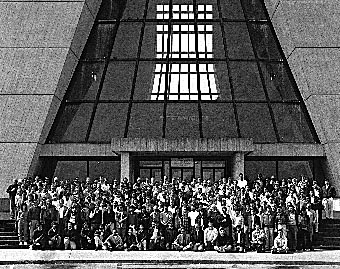Inquiring Minds
|
Physics at Fermilab main page | accelerators | collider experiments | neutrino physics | technology computing | theory | astrophysics | discoveries at Fermilab |
|
|
|
 A look back in time: CDF Collider Detector at Fermilab in 1995
A look back in time: CDF Collider Detector at Fermilab in 1995
CDF is one of two teams of experimenters studying the fundamental nature of matter in particle collisions at Fermilab's Tevatron, the world's most powerful particle accelerator. If you were part of the Fermilab collaboration known as CDF, for "Collider Detector at Fermilab," you would have 438 collaborators from 36 universities and laboratories working alongside you to find and study the top quark. You would be part of "big science" at a Department of Energy national laboratory. Twenty years ago, a group of a half-dozen physicists could build and operate a detector and expect to get important physics results from their experiments. Today's experiment collaborations have expanded because the instruments required for high-energy physics research are now so large and complex that it takes hundreds of people to design, build and operate them. Collider detector experiments also require the efforts of hundreds of scientists to manage and analyze the data they collect. CDF collaborators
Collaborators , Affiliations and
Spokespersons in CDF Collaboration
As a CDF physicist or graduate student working on the experiment, you might have helped design and build one of the most advanced particle detectors in existence, a 5,000-ton three-story marvel of sophisticated circuitry and engineering with 100,000 electronic channels to scan and record a quarter million particle collisions every second. You might be part of a team to upgrade the detector's components to keep pace with improvements in the Fermilab particle accelerator. You would take your share of eight-hour shifts as part of the control-room crew monitoring detector performance 24 hours a day, seven days a week. When you weren't on shift, you might wear a beeper, so that if a part of the detector on which you were the expert began to malfunction, the crew could call you to help fix it. You would almost certainly work with computers, perhaps as part of the effort to detect and store data from the billions of collisions as they occur. You might work on the instructions that tell the computers which of the billions of events that occur are worth saving for later study. Once the data were stored, you might have a part in turning them into physics results, an effort nearly as complex as building the detector itself. You might write computer code to turn the electronic signals from the detector into usable physics information. Or perhaps you would work on different code to allow computers to sift through this information in search of the particular collisions and particles you and your collaborators are seeking. Sometimes you would be physically present at Fermilab, but when you returned to your university in New York, or Los Angeles, Pisa or Tsukuba, the Internet would connect you with your collaborators all over the world. Hundreds of your far-flung fellow experimenters, working by themselves or in small groups, would share their conclusions--and their doubts about your conclusions--as though they were in the next office. Individually and together, using different analytical approaches to check and cross-check conclusions, you and your collaborators would try to understand what the data were telling you. You would not all have the same view. Your collaboration meetings would be lively, to say the least. When your experiment reached consensus and published a paper, the author list would take two or three pages. Nevertheless, regardless of the size of your collaboration or the dynamics of big science, you would be doing exactly what physicists have done since Galileo and Newton--using the power of scientific observation to test theory, and, perhaps, to discover some new dimension of the truth about nature. |
| last modified 02/26/2001 email Fermilab |
FRLsDFx9eyfrPXgV



 A 450-person experiment has within it many smaller groups with widely varying research interests, each making unique contributions. For example, within a collaboration, one group of experimenters may be interested in precisely measuring the mass of the W particle. Because of this research focus, the group may develop techniques that provide a better measurement of the top mass. Another group interested in measuring the b quark lifetime may improve the method of b quark identification in top quark decays. Still other groups work on important physics issues unrelated to the top quark. It's a different style of research from the days of go-it-alone discovery.
A 450-person experiment has within it many smaller groups with widely varying research interests, each making unique contributions. For example, within a collaboration, one group of experimenters may be interested in precisely measuring the mass of the W particle. Because of this research focus, the group may develop techniques that provide a better measurement of the top mass. Another group interested in measuring the b quark lifetime may improve the method of b quark identification in top quark decays. Still other groups work on important physics issues unrelated to the top quark. It's a different style of research from the days of go-it-alone discovery.